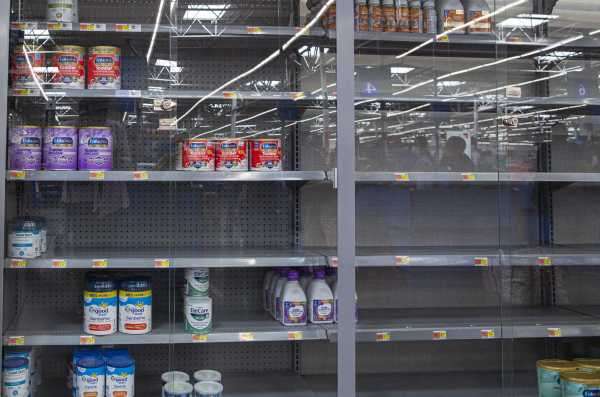
One infant formula factory shut down in February and started a supply chain reaction that has put thousands of American infants and children at risk of going hungry. Four months later, the United States is still experiencing its worst-ever baby formula shortage, forced to fly emergency provisions in from Europe and Australia.
How could that be? How could the market that provides sustenance to children across the country be vulnerable to such a massive disruption?
The story of how the US formula market got into this mess starts with two companies that have fought to preserve their dominance over the baby formula industry — with help from a federal program that guarantees companies huge sales.
What is clear now, advocates say, is that the formula industry is in desperate need of reform. The shortages of the last few months can’t be repeated.
“Everything needs to be on the table to figure out how to prevent this from happening again,” Brian Dittmeier, senior director of public policy at the National WIC Association, which advocates for the low-income women and children who depend on government assistance for nutrition, told me.
Why so few companies make infant formula in the United States
The baby formula industry is composed primarily of two longstanding giants (Abbott and Mead Johnson), each of which has a market share that hovers around 40 percent. A third manufacturer entered the market more recently (Nestle/Gerber), and there’s a line of generic store brands (made largely by Perrigo Nutritionals). Abbott, the producer of the Similac line and specialty formulas, had to shut down a Michigan plant in February over safety concerns.
The shutdown created a massive shortage. Abbott controlled more than 40 percent of the formula market. The Michigan factory was responsible for half of domestic production, and was the only facility that made some of Abbott’s products. The plan is for that factory to finally reopen on June 4 this weekend. But the damage is already done. Children have ended up in the hospital as parents have resorted to desperate measures, like dangerously diluting the formula they have,
Mead and the other manufacturers have not been able to make up the shortfall, even though they told Congress they knew as soon as Abbott’s plant shut down that it would be a serious problem.
Why are so few companies making formula? One reason is the market itself. The customer base is naturally limited, as infants grow up and age out of eating formula. US birth rates had stalled and then steadily dropped for years, before finally seeing a small uptick in 2021. Formula manufacturers have successfully marketed their product to new families, which at least partly explains America’s low breastfeeding rates compared to most other developed countries. But public health efforts have managed to start pushing breastfeeding rates up in recent years.
“That doesn’t scream to me that this is an attractive growing market,” David Davis, a South Dakota State University economist who has studied baby formula sales, told me.
Major multinationals like Abbott and Mead Johnson have also been willing to flex their power to protect their market share and limit competition.
The Federal Trade Commission investigated the infant formula industry in the early 1990s, when Nestle/Gerber was considering a move into the market. Mead settled with the feds before any lawsuits were filed, but the agency filed antitrust charges alleging that Abbott had participated in price-rigging and that it colluded with other companies to limit direct-to-consumer advertising. One of the lawsuits was settled, and a federal judge ruled in favor of Abbott in another.
FDA standards and federal contracting rules are partly a reflection of the companies’ lobbying influence with policymakers, experts told me. As Davis put it: “They don’t play nice.”
Baby formula is also difficult to produce, especially maintaining safety standards, which is why the existing manufacturers have concentrated operations in a few facilities outfitted for the task, such as the Abbott factory that shut down.
Finally, formula is “highly regulated,” Jae Kim, a pediatric neonatologist at Cincinnati Children’s Hospital, told me. “I would consider this a barrier for new companies trying to compete both in the past and now.”
The FDA has different standards for approval, safety, and even labeling of formula than regulators in Europe. This limits many formula imports. The United States is also one of a handful of countries that has not signed a World Health Organization code on baby formula, which included labeling rules.
Baby formula is also subject to significant tariffs. As part of the new trade agreement signed by the US, Mexico, and Canada during President Donald Trump’s term, Canada agreed to place a new surcharge on any formula it exports if overall exports exceed a certain limit. That has effectively shut off the US from accessing the formula supply of its northern neighbor during the current crisis.
Over the long term, tariffs and the different standards for labeling and inspections are “probably the big things” that prevent more companies from selling formula in the United States, Davis told me.
Federal contracting rules have also limited the infant formula market
Abbott and Mead Johnson haven’t dominated the formula market on their own. The federal government has helped.
The federal Woman, Infants, and Children program, which covers about 6 million people and helps low-income pregnant women and families afford certain staple products, subsidizing the purchase of more than half of the baby formula in the United States. Since the 1980s, WIC has had a rebate policy in place that effectively gives monopolies to formula manufacturers in individual states. The federal government provides the money for WIC, but states administer it, contracting with formula companies to provide all of the formula for WIC recipients in that state. The companies provide the government a rebate on the cost of those purchases.
But the rebate’s effect goes beyond WIC recipients.
Research from the Economic Research Service found that when a company holds a state’s WIC contract, it ends up consuming almost all of the formula market in that state. The spillover effect is so dramatic that, in California, Abbott went from controlling about 90 percent of the market when it held the state’s contract to about 5 percent the year after it lost the rights.
Davis emphasized that the rebate program does save the government a lot of money — about $1.6 billion annually — and helped expand the number of people covered by the program. But the importance of WIC to the overall US market, and this unusual feature resulting from federal policy, adds another barrier to a company attempting to enter the formula market.
With the current shortage now extending into another calendar month, advocates are pushing for action to reform the formula market. The FTC has launched an inquiry, and WIC is expected to take a hard look at the issue as well.
Dittmeier at the National WIC Association told me that, at the very least, the formula industry must create redundancies that would prevent the closure of a single factory from disrupting the supply of infant formula so severely. But “full-scale reform” should also be on the table, he said, which would include “re-evaluating our relationship with imports.”
“This needs to be an inflection point for the manufacturing sector,” he said.
Correction, 7 pm: An earlier version of this article misnamed the maker of generic store brand baby formula. It is Perrigo Nutritionals.
Will you support Vox’s explanatory journalism?
Millions turn to Vox to understand what’s happening in the news. Our mission has never been more vital than it is in this moment: to empower through understanding. Financial contributions from our readers are a critical part of supporting our resource-intensive work and help us keep our journalism free for all. Please consider making a contribution to Vox today.
Sourse: vox.com






